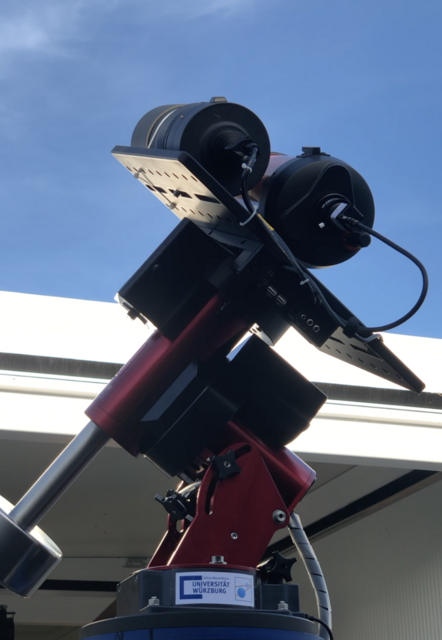TLP Observation
Overview
A new telescope has been set up in Spain in 2018. It is remotely operated from Würzburg since then.


Overview
This Transient Lunar Phenomena (TLP) project has been accomplished during an engineering internship by master student Helge Mohn. It deals with the development of an automatic TLP observation station. TLP can be visible with the naked eye, have been reported since centuries, but are still not entirely understood for the time being.
![Moonspy TLP Observation Station [Helge Mohn, 2014]](/fileadmin/_migrated/RTE/RTEmagicC_moonspy_system.jpg.jpg) To comprehend this phenomena the outcome of this project presents a new approach of a transportable observation station to achieve automatic TLP recordings. Good observation data is of great importance to do further research and to finally gain a more detailed and maybe a new adapted knowledge of the Earth’s Moon.
To comprehend this phenomena the outcome of this project presents a new approach of a transportable observation station to achieve automatic TLP recordings. Good observation data is of great importance to do further research and to finally gain a more detailed and maybe a new adapted knowledge of the Earth’s Moon.
Therefore the overall technical requirements and performance of such a machine have been researched to accomplish automatic TLP recordings. During this engineering internship this machine called „Moonspy“ has been designed, built and programmed. Finally this machine has been very successfully put to the test, being able to do automatic slewing, TLP detection and recordings.
Features
The field of view has been chosen in such a way, that the whole moon is captured within the frame no matter the moon is in apogee or perigee. Combined with the sensor an angular resolution has been chosen to accomplish a resolution 5 km/pixel. The optics and the sensor are pointed to the moon by the use of a mount. The Celestron SkyProdigy mount uses a star camera to do a high accurate automatic alignment and enables a very smooth slewing to track the moon.
This system elements combined with a processing unit enabled the software development of the TLP detection software called “Moonspy”. The chosen monochrome sensor has a frame rate of up to 50 frames per second. Each frame is analysed for a change in brightness, which under certain circumstances would trigger an automatic recording.
![Moonspy System in Action [Helge Mohn, 2014]](/fileadmin/_migrated/RTE/RTEmagicC_moonspy_action.png.png)
Helge Mohn (December 2014)
For more information contact:


